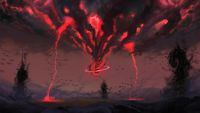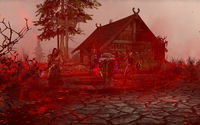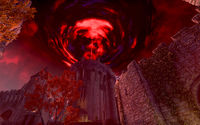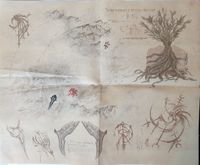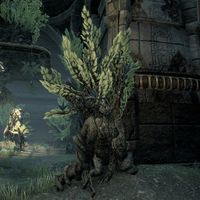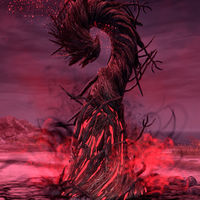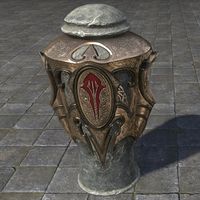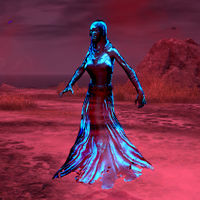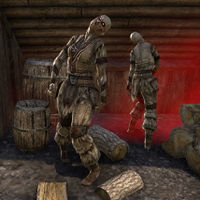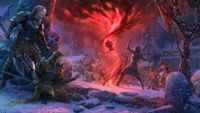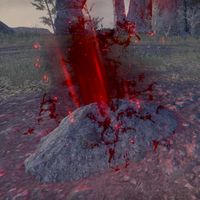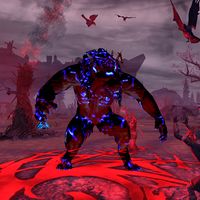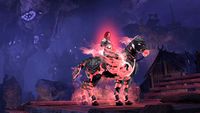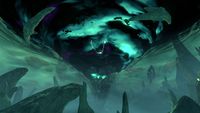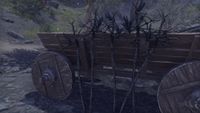Lore:Harrowstorms
Harrowstorms are arcane weather events created with a combination of the magic of the Icereach Coven and ancient vampire alchemy that appeared without too much warning, leaving death and destruction behind. The energies created by those storms were capable of instantly killing many people or transforming them into near-mindless shells known as harrowed, although others become feral vampires known as harrowfiends, but some who were in the vicinity of the storms were not always affected.[1] The use of the ritual fetishes and alchemy needed to summon harrowstorms is known as harrowcraft.[2]
Historical Use[edit]
Around the year 2E 582, harrowstorms were used several times by the Icereach Coven and the Gray Host in order to further their plans in the regions of Western Skyrim, parts of Blackreach and the Reach.[3][4]
In Western Skyrim, random harrowstorms were often summoned in order to allow the Nords to fret over them while the Host prepared more powerful versions.[5] The Swords of Solitude, one militia of Haafingar, often recruited groups of volunteers to deal with those storms that occurred all over the region.[6]
Near the city of Solitude, a storm was summoned against the temple of Kilkreath, a temple dedicated to the Daedric Prince Meridia, with the storm being met with unexpected resistance, as the enemies of the Host noticed the movements and sought to reveal their plans.[7] Despite the resistance, the storm was still devastating, killing many of the priests and affecting the interior of the temple as well.[8] Efforts were later made to stop the remaining corruption, but a legacy of the harrowstorm was the abandonment of the temple, which was still found in ruins about a thousand years later in 4E 201.[9][8][10]
A failed attempt at summoning a harrowstorm was made near the underground city of Dusktown, as the Vestige and their allies were able to destroy the ritual pikes involved in the ritual. Despite the success, energies collected by the harrowstorms were still capable of resurrecting Exarch Ulfra of the Gray Host, a powerful werewolf behemoth.[11]
Another attempt of using a harrowstorm happened near the town of Morthal, which caught several soldiers of the city, but the witch pike that supported the storm was destroyed soon after and the location was spared. Meanwhile, the hold capital of Karthwatch was not so lucky, with the city being devastated by another storm, transforming many of the locals and even the jarl into harrowfiends. The storm, combined with other factors, allowed for Karthwatch and the rest of the Karthald hold to eventually cease existing as its people were either dead or scattered.[12]
After the death of Exarch Tzinghalis, the Gray Host was preparing a test of a "final harrowstorm" in the Undergrove, a place located within an ancient barrow.[13] The plans for this massive storm were discovered, with several defenders of Skyrim beginning preparations for an elixir that would be able to hold the effects of the arcane phenomena, with this elixir being tested on the Undergrove and proving successful, with the Undergrove's storm being destroyed right after.[14]
Eventually, this final harrowstorm was completed and unleashed from within Greymoor Keep, rising to affect the capital city of Solitude, with the Host using it to resurrect the last of their numbers. Many exposed to the storm had their life energies taken by it, but efforts of the defenders of the city among others were able to stop the storm and kill High King Svargrim, who had been merged with Greymoor Keep and thus his end meant the end of the harrowstorm as well.[15]
In the aftermath, the elixir against the harrowstorms were distributed to the holds and there were hopes of producing a cure for the harrowed, but not for the harrowfiends who had more of their life energies removed from them.[16]
Later during their campaign in the Reach, similar random harrowstorms appeared in several areas of the region, with the city of Markarth having an agent that recruited outsiders to deal with them.[17] Storms were frequent enough in the region to the point that the agent of Markarth pointed out that new ones would likely appear in the next day.[18]
Ingredients[edit]
One of the ingredients for the harrowstorms is a plant known as netherroot that only grows in isolated patches in the depths of Blackreach, the Gray Host studied the plants in order to improve the concoction for the harrowstorms even further to create more effective and powerful results. Eventually, the effects of those studies allowed for a more complete exchange of energy and better versions by the day.[19]
The Icereach Coven did not use a single variation of netherroot, as a variety that grows in large quantities beneath the village of Karthwasten was also sought, this different form required another component but still served the Coven's purposes quite well. The root itself grew not only in larger numbers, but also faster and would be able to create more powerful harrowstorms if used.[20]
Ritual pikes were used to keep the storms active, the Icereach Coven was eventually able to prepare the storms with a single pike after enough development, this smaller version did not provide large storms but still harvested the life force the Coven wanted.[21]
Another powerful reagent necessary was a gray reliquary.[22] Those ancient ominous stone vessels contained the ancient charred remains of the members of the Gray Host and were considered a haunting addition to even the darkest crypts when not used for the storms.[23]
Effects[edit]
The effects of the harrowstorms were the extraction of the life energies of the living within their area of influence, killing or transforming the ones they touched. The deaths and the transformation into bloodfiends known as harrowfiends were considered to be a side-effect, being observed in many moments, even when the Icereach Coven was still improving the harrowstorms to be larger and affect populated areas.[24]
By design, lycanthropes were immune to the effects of the harrowstorms, but studies were being made by using netherroot and blood distillate of werewolves in order to weaken them. There were still questions about whether or not the soul would be able to be exchanged when it succumbed to the ritual though.[25]
Gallery[edit]
-
The Darkstorm
See Also[edit]
- For game-specific information, see the Elder Scrolls Online article.
References[edit]
- ^ On Harrowstorms — Fennorian of House Ravenwatch
- ^ Tayfaern's dialogue in ESO
- ^ Events of ESO: Greymoor
- ^ Events of ESO: Markarth
- ^ Gray Host Communique — Rada al-Saran
- ^ Events of Halt the Harrowstorms (Greymoor) in ESO
- ^ Pentarch's Orders — R
- ^ a b Priest Bavian's dialogue in ESO: Greymoor
- ^ Events of Meridia's Brilliance in ESO
- ^ Events of Skyrim
- ^ Events of Dark Clouds Over Solitude in ESO
- ^ Events of Danger in the Holds in ESO
- ^ Gray Host Orders — Rada al-Saran
- ^ Events of The Gray Host in ESO
- ^ Events of Greymoor Rising in ESO
- ^ Events of Daughter of the Wolf in ESO
- ^ Events of Halt the Harrowstorms (Markarth) in ESO
- ^ Nelldena's dialogue in ESO: Markarth
- ^ Netherroot Notes — Exarch Tzinghalis
- ^ Orders from R — R
- ^ Sister Elra's Proclamation — Sister Elra
- ^ Letter from Sister Glynolde — Sister Glynolde
- ^ Gray Reliquary item description in ESO
- ^ Icereach Coven Note — Sister Balra
- ^ Lycanthropic Immunity — Exarch Tzinghalis
|
||||||||||||||||||||||
